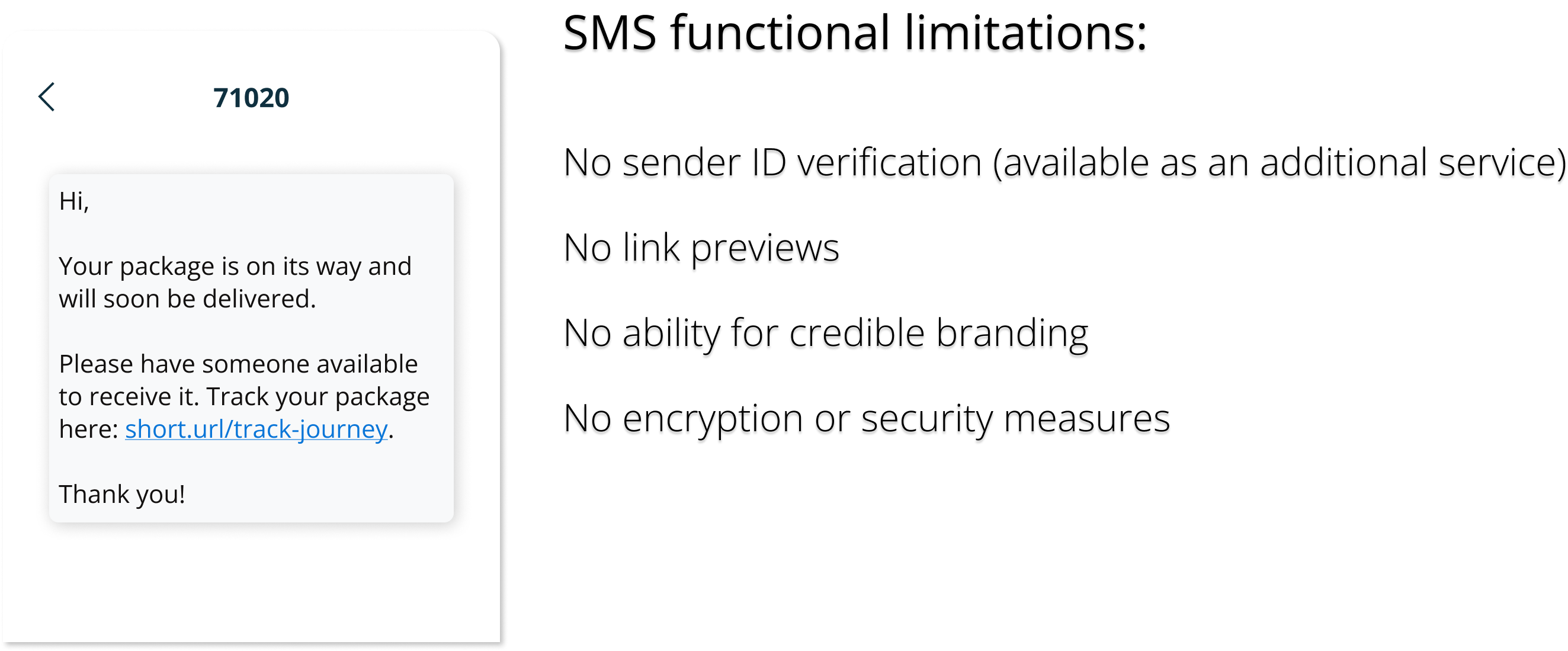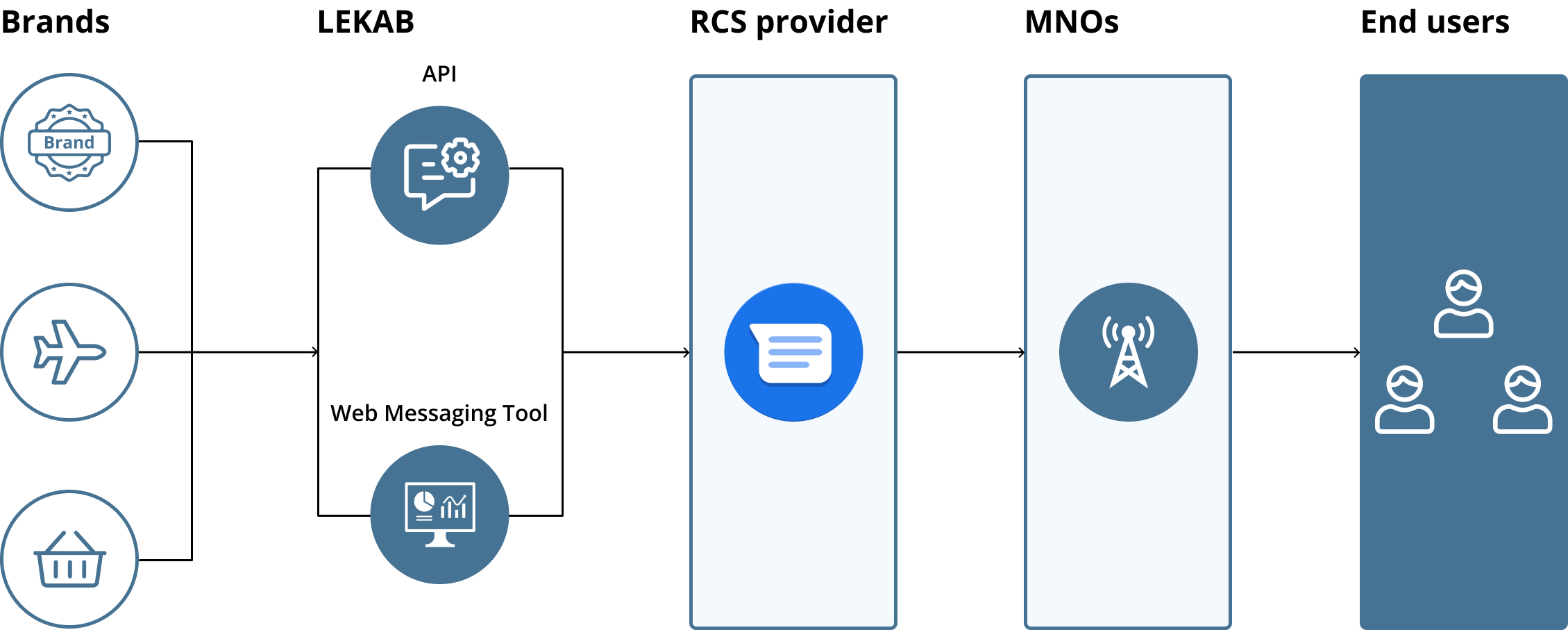Rich Communication Services (RCS), often referred to as the new generation of SMS, has firmly established itself as an innovative communication channel for businesses to revamp their communication strategies and maximise customer engagement. But what really is the difference between SMS and RCS? Let's take a look.
What is RCS?
Rich Communication Services (RCS), also known as RBM (RCS Business Messaging), is a digital communication channel used for person-to-person (P2P) and application-to-person (A2P) communication. Like SMS, RCS delivers messages directly to mobile phones through the pre-installed messaging application. RCS is an intriguing channel for businesses as the technology presents unique advantages that foster customer dialogue, interactivity, brand customisation, and security.
There has been talk about RCS for many years. Now, the technology is catching up, and Swedish mobile operators are gradually integrating Rich Communication Services (RCS) into their mobile network.
RCS was developed back in 2007 with the aim of creating a competitive alternative to over-the-top (OTT) channels on the market, such as WhatsApp and Messenger. The goal was to enhance messaging features and provide users with a richer and more interactive communication experience directly within the mobile phone's pre-installed messaging application. Google played a significant role in RCS development through the acquisition of Jibe Mobile in 2015, a key player in RCS. In 2018, Google integrated the technology into the standard messaging app on all Android phones. This step became a crucial milestone for adopting RCS in Android devices.
So far, only Android phones have supported the new technology, but this may soon change in 2024 as Apple is expected to make it available.
RCS usage is steadily growing and is currently fully available in several countries, such as the USA, France, India, the UK, and Brazil. Here, you can learn how to activate RCS on an Android device.
Limitations and Challenges with SMS
SMS, which stands for Short Message Service, is exactly as it sounds – a format that supports a limited number of characters. When the SMS protocol was developed in the 1980s, it did not initially support emojis or images. At its launch in 1992, an SMS contained 160 characters.
The SMS technology, supported by all mobile phones (regardless of Android and IOS operating systems) and all network operators globally, has become a crucial part of companies' communication strategies, enabling swift and direct communication with customers and other stakeholders for various purposes, such as booking confirmations, reminders, delivery notifications, and security messages like PIN codes and alarms, among other use cases.
Today, we can send longer messages, links, and emojis, but there is still a lack of functionality for a secure and engaging recipient experience.

RCS functions
With its numerous features and an app-like experience, businesses can take their communication strategy to the next level with the new technology RCS. We have compiled some of the features RCS offers to create visually appealing, engaging, and secure messages that can lead to more clicks, higher conversion rates, and sales, as well as an enhanced customer experience and engagement..png?width=713&height=574&name=Sk%C3%A4rmavbild%202024-03-27%20kl.%2016.05.43%20(1).png)
Key features of RCS
- Branded messages with logos and colors for an enhanced customer experience.
- Verified sender for clear identification of the sender and increased security, ensuring the recipient knows which company they are communicating with..
- Rich media elements such as videos, audio files, GIFs, image carousels, and geolocation services are embedded in the message (up to 10 MB).
- Interactive response options with reply buttons can increase the response rate to messages by allowing customers to reply with a single button embedded in the conversation.
- Option for automatic responses for swift and pre-programmed communication, for increased efficiency.
- Longer messages, 1000 characters in one message (vs. 160 characters per SMS).
- Barcode delivery is sending messages containing barcodes that customers can scan with their smartphones and be directed to a specific landing page, website, or app.
RCS for a richer customer experience
RCS enables a richer and more tailored customer experience. With an impressive open rate of 50% within the first 15 seconds, RCS messages immediately capture interest and prompt swift responses from recipients.
RCS boasts a 2.5 times higher conversion rate than SMS, clearly demonstrating its ability to enhance both engagement and interaction. Businesses utilising RCS experience an average basket size increase of +9% compared to SMS. This underscores the significance of RCS in improving customer purchasing behavior and contributing to overall business outcomes.
The statistics below clearly indicate that RCS not only increases engagement but also significantly enhances conversion rates and total sales for businesses.

ABOUT LEKAB
LEKAB provides RCS to corporate clients. Select your use case and seamlessly integrate RCS functionality into your systems using our APIs.

LEKAB provides mobile messaging services, SMS Gateway and messaging APIs and software for advanced business messaging and process automation. We offer digital tools and solutions to companies that want to optimise how they communicate and interact with customers and employees on the mobile to improve productivity, availability and the customer experience through mobile channels. Do you want to know more or ask us for advice? Contact Us!
